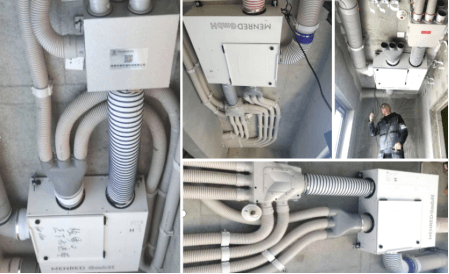Energy recovery ventilation system
views: 5561 time: 2022-12-02
views: 5561 time: 2022-12-02
Energy recovery ventilation, often abbreviated as ERV, is an energy recovery process in HVAC system. It takes full advantage of the energy from indoor exhaust, and exchanges energy with outdoor supply air. In this way, it can minimize the waste of energy for the purpose of saving energy for both air conditioning and floor heating. The key component of an ERV system is a membrane-based enthalpy exchanger. Another common type of ventilation device on the market is called heat recovery ventilation, or HRV.
For spaces requiring mechanical ventilation systems, two common types of ventilation are Heat Recovery Ventilation (HRV) and Energy Recovery Ventilation (ERV). HRV can only recover sensible heat from indoor exhaust, whereas ERV is able to recover both sensible heat and latent heat. Sensible heat refers to noticeable changes of temperature. However, there are latent heat referring to heat change that is hidden, meaning it occurs without a change of temperature. A typical example of latent heat is a phase change such as the melting of ice(0℃), where heat energy is needed for a phase change without change of temperature. Given that ERV can recover both sensible heat and latent heat, ERV is also considered as an enthalpy exchanger. ERV system works the same way HRV system does, but a residential ERV system can help maintain the humidity balance within the room.

Unlike existing paper cores, a special ERV core is made of durable polymer membranes with following advantages: replacement free, washable, moisture resistant, frost resistant, mold resistant, effective germ elimination and zero air leakage. The membrane core is where the energy exchange occurs, providing constant fresh air to the room while minimizing energy loss. The membrane core enables the exchange of temperature and moisture between indoor return air and outdoor incoming air, effectively reducing the workload of air conditioning and shortening the time required for cooling or heating.
Energy recovery ventilation system circulates air by introducing outdoor air and exhausting indoor return air. The membrane-based enthalpy exchanger is set up between outdoor air and return air as an air-handling system. Two centrifugal blowers and a filter are also embedded within the ERV system. One blower pulls stale indoor air to the outside, the other pulls fresh outdoor air to the inside. The fresh air entering the enthalpy exchanger first passes through the filter, which effectively prevents pm2.5 from entering the room. It then goes through the membrane core where the exchange of temperature and humidity starts. Sensible heat from return air is used for preheating or precooling the fresh air; latent heat from return air is used for humidifying or dehumidifying. At the final stage, fresh air goes into the room and stale air is exhausted to the outside.